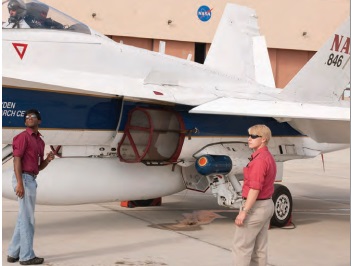Chapter: Supersonic Flight Research, new invention technology, Research project papers,
Airborne Schlieren Imaging System (ASIS)

Airborne
Schlieren Imaging System (ASIS)
Armstrong
researchers are using a schlieren technique to capture images of shock waves
emanating from aircraft in supersonic flight. For supersonic flight to
ultimately become acceptable, it is necessary to study the shocks and quiet the
boom. The ASIS technique captures images of shocks by aligning a supersonic
aircraft between a camera-equipped aircraft and the sun, and then watching as
the shocks put an apparent ripple on the sun's edge. This technique allows for
side-view imaging at operational altitudes where typical supersonic flights are
expected to occur. These images will enable
researchers to validate data from supersonic models and wind tunnel tests.
Work
to date: The team conducted a proof-of-concept
demonstration of the ASIS technique during a February 2014 flight
test and is evaluating the results.
Looking ahead: The
team will continue to test and mature the technology. The
sun-ripple concept and aircraft alignment algorithms developed for ASIS are
being considered for use on future projects. The team is working to identify
potential research partners.
Benefits
Innovative: Captures
side-view images of shock waves, as opposed to the top-down or mostly
bottom-up images captured by other techniques
Accurate: Enables
precise sonic boom estimation by validating supersonic models and wind
tunnel tests
Supersonic Flight Research
Supersonic flight over land is currently
severely restricted because sonic booms created by shock waves disturb people
on the ground and can damage private property. Since the maximum loudness of a
sonic boom is not specifically defined by the current Federal Aviation
Administration (FAA) regulation, innovators at NASA have been researching ways
to identify a loudness level that is acceptable to both the FAA and the public
and to reduce the noise created by supersonic aircraft. Using cutting-edge
testing that builds on previous supersonic research, NASA is exploring low-boom
aircraft designs and other strategies that show promise for reducing sonic boom
levels.
A variety of factors, from the shape and
position of aircraft components to the propulsion system's characteristics,
determine the make-up of a supersonic aircraft's sonic boom.
Related Topics